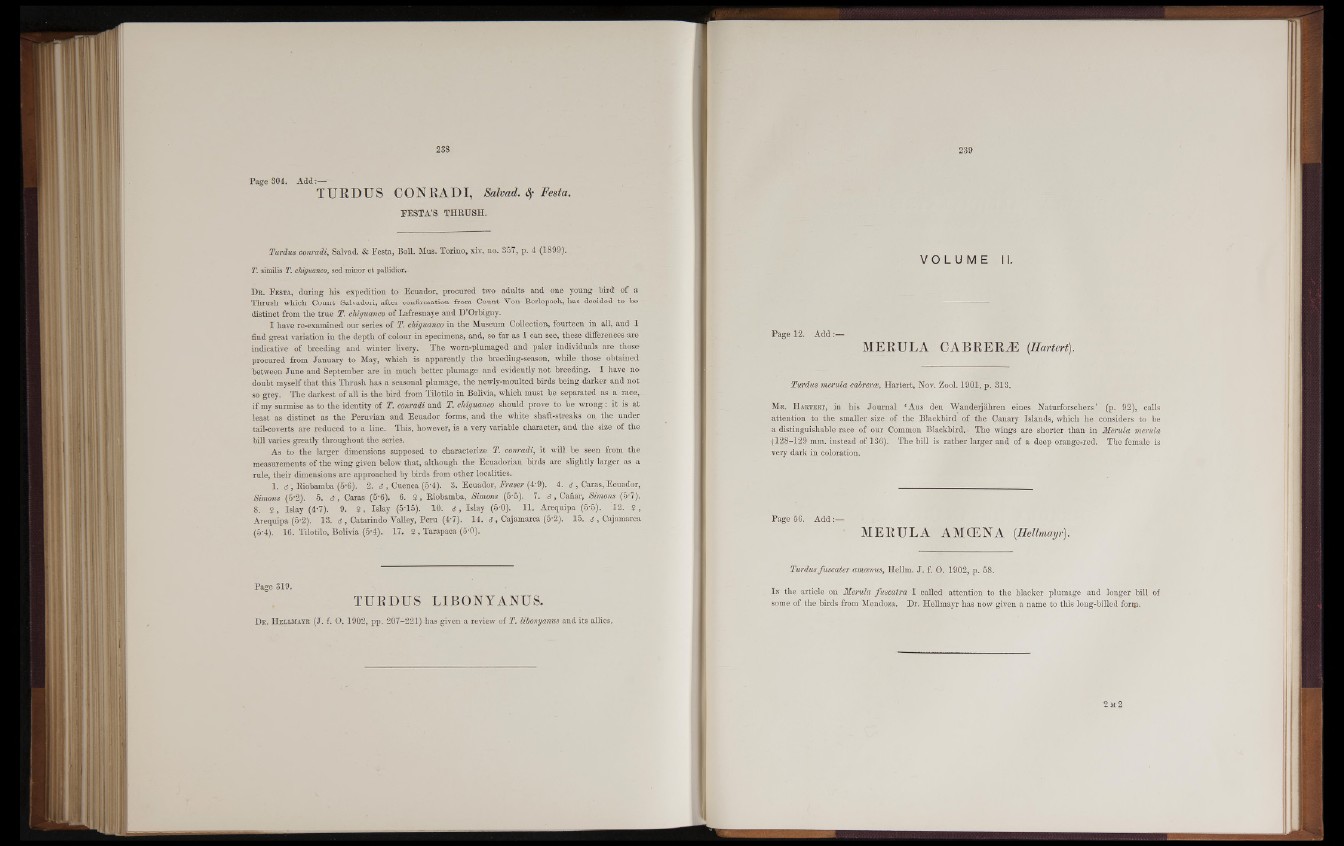
Page 304. Add-:—
T U R D U S CON KADI , Salvad. $ Festa.
FESTA’S THRUSH.
Tardus conradi, Salvad. & Festa, Boll. Mus. Torino, xiv. no. 357, p. 4 (1899).
T. similis T. chiguanco, sed minor et pallidior.
X)b . F esta, during his expedition to Ecuador, procured two adults and one young bird of a
Thrush which Count Salvadori, after confirmation from Count Yon Berlepsch, has decided to he
distinct from the true T. chiguanco of Lafresnaje and D’Orbigny.
I have re-examined our series of T. chiguanco in the Museum Collection, fourteen in all, and X
find great variation in the depth of colour in specimens, and, so far as I can see, these differences, are
indicative of breeding and winter livery. The wom-plumaged and paler individuals are those
procured from January to May, which is apparently the hreediug-season, while those obtained
between June and September are in much better plumage and evidently not breeding. I have no
doubt myself that this Thrush has a seasonal plumage, the newly-moulted birds being darker and not
so grey. The darkest of all is the bird from Tilotilo in Bolivia, which must be separated as a race,-
if my surmise as to the identity of T. conradi and T. chiguanco should prove to be wrong: it is at
least as distinct as the Peruvian and Ecuador forms, and the white shaft-streaks on the under
tail-coverts axe reduced to a line. This, however, is a very variable character, and the size of the
bill varies greatly throughout the series.
As to the larger dimensions supposed to characterize T. conradi, it will be seen from the
measurements of the wing given below that, although the Ecuadorian birds are slightly larger as a
rule, their dimensions are approached by birds from other localities.
1. a , Riobamba (5-6). 2. a , Cuenca (5'4). 3. Ecuador, Fraser (4-9). 4. <?, Caras,Ecuador,
Simons (5-2). 5. a , Caras (5'6). 6. 2 , Riobamba, Simons (5-5). 7. d.Canar, Simons (5'7).
s. 2 , Islay (4-7). 9. 2 , Islay (5T5). 10. a , Islay (5-0). 11. Arequipa (5-5). 12. 2 ,
Arequipa (5-2). 13. a , Catarindo Valley, Peru (4-7). 14. a , Cajamarca (5’2). 15. a , Cajamarca
(5-4). 16. Tilotilo, Bolivia (5-4). 17. 2 , Tarapaca (5-0).
Page 3 1 9 .
T U R D U S L IB O N Y A N U S .
B e . H ellmayr (J. f . 0 . 1 9 0 2 , p p . 2 0 7 - 2 2 1 ) h a s g iv e n a r e v iew o f T. liboryanus a n d its a llie s .
V O L U M E II.
Page 12. Add
MERULA CABRERAS {Hartert).
Turdus merula cabreros, Hartert, Nov. Zool. 1901, p. 313.
M r. H artert, in his Journal £Aus den Wandeijahren eines Naturforschers ’ (p. 92), calls
attention to the smaller size of the Blackbird of the Canary Islands, which he considers to be
a distinguishable race of our Common Blackbird. * The wings are shorter than in Merula merula
(128-129 mm. instead of 136). The bill is rather larger and of a deep orange-red. The female is
very dark in coloration.
Page 5G. Add :—
M E R U L A AM CENA [Hellmayr).
Turdus fuscater amcenus, Hellm. J. f. O. 1902, p. 58.
In the article on Merula fuscatra I called attention to the blacker plumage and longer bill of
some of the birds from Mendoza. Dr. Hellmayr has now given a name to this long-billed forijpi.